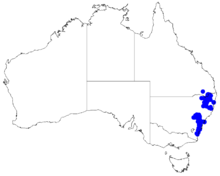Boronia microphylla
Boronia microphylla, commonly known as small-leaved boronia, is a plant in the citrus family Rutaceae and is endemic to eastern Australia. It is a shrub with pinnate leaves with small leaflets and pink, four-petalled flowers.
| Small-leaved boronia | |
|---|---|
.jpg) | |
| Boronia microphylla leaves and flowers | |
| Scientific classification | |
| Kingdom: | Plantae |
| Clade: | Tracheophytes |
| Clade: | Angiosperms |
| Clade: | Eudicots |
| Clade: | Rosids |
| Order: | Sapindales |
| Family: | Rutaceae |
| Genus: | Boronia |
| Species: | B. microphylla |
| Binomial name | |
| Boronia microphylla | |
 | |
| Occurrence data from Australasian Virtual Herbarium | |
Description
Boronia microphylla is a shrub which grows to a height of 0.3–1.0 m (1–3 ft). Its youngest branches are covered with small, warty glands and scattered bristly hairs. It has pinnate leaves with 5 to 15 leaflets on a rachis 3–16 mm (0.1–0.6 in) long and a petiole 2–8 mm (0.08–0.3 in) long. The leaflets are spatula-shaped to wedge-shaped, 3–8 mm (0.1–0.3 in) long, 1–4 mm (0.04–0.2 in) wide and glabrous.[2][3]
The flowers are pink to purplish and are arranged mostly in the upper leaf axils in groups of up to five on a stalk 3–10 mm (0.1–0.4 in) long. The four petals are 5–8 mm (0.2–0.3 in) long and glabrous. Flowering occurs from October to February.[2][3]
Taxonomy and naming
Boronia microphylla was first formally described in 1825 by Franz Sieber and the description was published in Ludwig Reichenbach's Iconographia Botanica Exotica.[4][5] The specific epithet (microphylla) is derived from the Ancient Greek words mikros meaning "little"[6]:488 and phyllon meaning "leaf".[6]:466
Distribution and habitat
This boronia grows in heath and forest in coastal areas north from Moruya in New South Wales to near Stanthorpe in Queensland, including areas inland as far as the Great Dividing Range.[2][7][8]
Use in horticulture
Boronias are not usually easy to grow in the garden, but this species is one of the hardiest as long as it is grown in a protected position and given adequate water. It is most easily propagated from cuttings.[7]
Gallery
_Torrington.jpg) Boronia microphylla in the Torrington State Conservation Area
Boronia microphylla in the Torrington State Conservation Area_in_ANBG.jpg) B. microphylla in the ANBG
B. microphylla in the ANBG.jpg) B. microphylla in the ANBG
B. microphylla in the ANBG B. microphylla in the Gibraltar Range National Park
B. microphylla in the Gibraltar Range National Park B. microphylla (white flowers) in the Gibraltar Range
B. microphylla (white flowers) in the Gibraltar Range.jpg) B. microphylla in the Washpool National Park
B. microphylla in the Washpool National Park
References
- "Boronia microphylla". Australian Plant Census. Retrieved 16 March 2019.
- Weston, Peter; Duretto, Marco. "Boronia microphylla". Royal Botanic Gardens Sydney: plantnet. Retrieved 11 November 2016.
- Harden, Gwen J. (ed.) (2002). Flora of New South Wales. Volume 2 (revised ed.). Sydney: New South Wales University Press. p. 275. ISBN 978-0868406091.CS1 maint: extra text: authors list (link)
- "Boronia microphylla". APNI. Retrieved 11 November 2016.
- Sieber, Franz; Reichenbach, Ludwig (1825). Iconographia Botanica Exotica. Leipzig: Friedrich Hofmeister. p. 53. Retrieved 11 November 2016.
- Brown, Roland Wilbur (1956). The Composition of Scientific Words. Washington, D.C.: Smithsonian Institution Press.
- "Boronia microphylla". Australian Native Plants Society Australia. Retrieved 11 November 2016.
- Duretto, Marco F.; Wilson, Paul G.; Ladiges, Pauline Y. "Boronia microphylla". Australian Biological Resources Study, Department of the Environment and Energy, Canberra. Retrieved 18 April 2019.